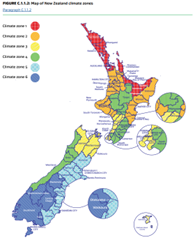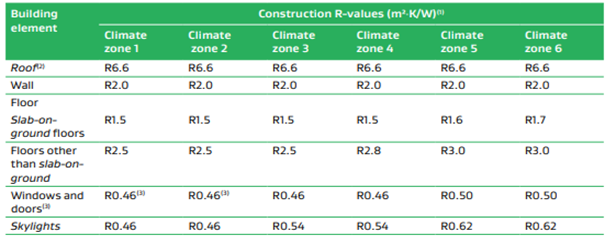Insulation levels
Two of the most common questions asked of Eco Design Advisors are how much insulation should be installed, and how do you know what difference it will make. To answer these questions there are a few basic concepts to understand.
- Heat always tries to flow from a warmer place to a colder place.
- Insulation reduces this heat flow by slowing it down.
- The unit used to measure resistance to heat flow is the R-value (m2 °C/W). The bigger the number, the better the resistance to heat flow.
- When building new you need to demonstrate you can meet the insulation requirements of the New Zealand Building Code (NZBC).
- The table below shows the minimum R-values required to meet the NZ building code for building elements (that do not contain embedded heating systems).
New Zealand is divided into six different climate zones

New Construction R-values Schedule

Notes
- There are alternative calculator and modelling methods that can be used to prove that required energy performance levels are met using different ratios of the various insulation values.
- R values stated are total construction R-value, considering heat losses through framing members.
- Refer to BRANZ House Insulation Guide 6th Edition, for options on achieving these desired construction R-values.
- Consult with your window supplier to ascertain what Rw value different options will give, or refer to BRANZ Bulletin 670; Specifying windows and doors under H1, for guidance: (Specifying windows and doors under H1)
What can we learn
Heating savings
Let’s look at a typical 1960s/1970s house and what insulation can do to improve the occupants’ comfort and reduce the heat requirements and running costs of the house.
Reduce heating requirement through more insulation (from no insulation to best levels)

Enery use for different levels of insulation.
The house with no insulation requires a massive 17kW of heat to keep the temperature at 20°C when it is 5°C outside. The biggest heat loss is through the ceiling, followed by the floor, with the windows and the walls losing similar amounts. That equates to $5.37 an hour to heat this small uninsulated house (at 2022 prices, ~31.5c/kWh).
Once insulated to the NZBC minimum, the heating requirement drops to 2.8kW, to maintain a comfortable 20°C. Now the biggest heat loss is through the glazing even though the house has been double glazed. The heating cost drops to 88 cents per hour, a saving of almost $4.50 per hour. If you can build to the better levels, the cost drops to only 56 cents an hour to heat the whole house!
If the house was able to be insulated to best levels, including installing the best windows, and higher spec insulation, savings will be even greater. Best levels may require a deeper ceiling cavity and wider than normal wall framing to accommodate thicker insulation, an insulated floor slab (including around the perimeter of the slab). In a well-oriented, solar designed house, it is possible in the more temperate parts of New Zealand to achieve a good level of thermal comfort with little or no space heating.
For further information
Contact your nearest Eco Design Advisor
Visit our website ecodesignadvisor.org.nz
View helpful resources at:
Download PDF
